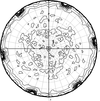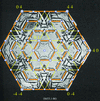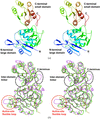issue contents
March 2005 issue

Cover illustration: The double heptameric rings of the PA-Sm1 core protein in complex with RNA are shown in an axial view with the two RNA binding domains, between the heptamers and in their central channel, respectively (p. 269). The hetagonal prismatic forms encasing the three subsystems have heights and radii related by heptagrammal scalings and are expressible in terms of a single parameter u. In particular, the Sm1 core subsystem has a radius re = 8u, an inter-ring distance d= 4u (double the value in the free state) and a total height H = 18u. The corresponding values for the RNA subsystem between the two heptamers are re' = 8u' and H' = 5u' where u' is scaled by the heptagrammal factor ![[mu]](/logos/entities/mu_rmgif.gif) = 0.8629 with respect to u. For the RNA located within the central cavity one has H' ' = 9u'. The Ca2+ ions (filled cyan circles) are located at the vertices of a heptagon in heptagrammal scaling in relation to the envelope as a whole.
= 0.8629 with respect to u. For the RNA located within the central cavity one has H' ' = 9u'. The Ca2+ ions (filled cyan circles) are located at the vertices of a heptagon in heptagrammal scaling in relation to the envelope as a whole.
research papers
 access
access

 journal menu
journal menu


































